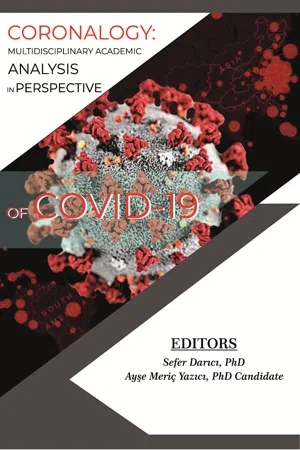
CORONALOGY: Multidisciplinary Academic Analysis in Perspective of Covid-19
- 250 pages
- English
- ePUB (mobile friendly)
- Available on iOS & Android
CORONALOGY: Multidisciplinary Academic Analysis in Perspective of Covid-19
About This Book
The book aims to contribute to the new paradigm of sense-able covid-19 from and analytical perspective of different disciplines, to define and relate that kinds of multi disciplines able to provide users with relation of contextual services, to relate and analyse their dynamics and to react accordingly, in a seamless exchange of information during pandemic terms. In this context the book's main aim is to understand the complexities of society's pandemic beginning from information that is theoretically accessible from various viewpoints, through a multidisciplinary approach and in multiple contexts, both indoors and outdoors. In addition, the book will be examined in COVID-19 and later changes and transformations.
ABSTRACTING & INDEXING
CORONALOGY: Multidisciplinary Academic Analysis in Perspective of Covid-19 is covered by the following services:
Baidu Scholar
Bayerische Staatsbibliothek
BoD
Bowker Book Data
Ciando
CNKI Scholar (China National Knowledge Infrastructure)
Dimensions
EBSCO
ExLibris
Google Books
Google Scholar
Naviga
ReadCube
Semantic Scholar
TDOne (TDNet)
WorldCat (OCLC)
X-MOL
Frequently asked questions
Table of contents
- Introduction
- Defining the Future: Before the Pandemic and Financial Transformation
- Introduction
- The COVID-19 pandemic, which has already infected almost 10.005,970 people in 188 countries, resulting in more than 500,000 deaths, has the potential to reach a large proportion of the global population (Johns Hopkins University Center for Systems, 2020). This grave picture of the pandemic is expected to continue. Especially the second wave expectation is increasing day by day. This will lead to deepening of macroeconomic problems. The effect of the COVID-19 outbreak on countries' economies emerges in many dimensions, one of which is the disruption of the supply chain. As a result of commercial globalization, the production structures of countries are articulated. Production processes are also disrupted as transportation and commercial activities between countries decrease due to the pandemic. With the COVID-19 pandemic embracing the entire world, countries began to take measures to keep households in their homes, one after the other, so that their health systems would not collapse. In addition, country borders were closed for free travel. Thus, the global economy began to suffer seriously. Naturally, the supply chain of the sectors that produce depending on the imported input was also negatively affected.
- The 1800s are years that mankind has begun to make more research and knowledge as compared to previous centuries. In this period, at the end of the century, (1889-1892) humanity faced an influenza pandemic (Park and Williams, 1919:45). This situation urged researchers to investigate and understand the microorganisms. Humanity faced other diseases (SARS, cholera, tuberculosis, plague, smallpox, dengue, AIDS, influenza) but they were more regional, not worldwide. But pandemic illnesses are worldwide. In the literature, although the 1918 pandemic is called the Spanish epidemic, mainly the Spanish people say that the epidemic came from the battlefields from the Alps and Pyrenees (from France) to Italy and Spain during the war. Here, Spain's problem was that when the disease started, many countries hid it from the world and said that it was Spaniards’ disease with 8 million deaths (in May and June) (Crosby, 2003: 26).
- The 1918 pandemic and the 1890 pandemic's emergence and development consisted of 3 stages (Royen and Rhodes, 1948: 567). In the Spanish flu, the disease appeared in the form of headache and fever and runny nose and cough, hoarseness in the first stage (first wave), and later triggered diseases such as the pharynx, larynx, trachea and conjunctivitis. These are the effects (most prominent) in the first wave of the virus. While the virus was evolving, it caused more pneumonia (20%) and deaths in the 2nd and 3rd waves. However, the first wave remained as rare events. The 2nd and 3rd waves (80 percent of influenza cases for France are in the 2nd wave) first started in autumn 1918 (September) and appeared in the third wave in the spring of 1919. The disease started mildly in the second wave, then turned into pneumonia. “The remaining 20 per cent, however, suffered from pneumonia and nearly half died“ (Royen and Rhodes, 1948: 562).